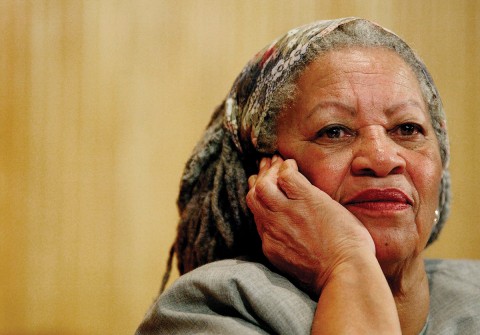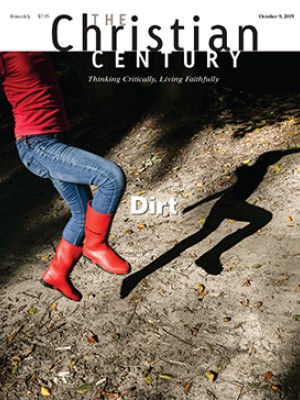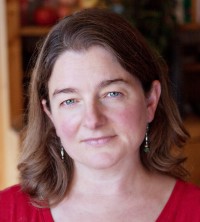The holiness of Toni Morrison’s fictional worlds
Faith, in Morrison’s novels, is about improvising a way toward freedom.

In Toni Morrison’s 2012 novel Home, Frank Money and his sister, Cee, are physically and spiritually broken when they return to the rural Georgia town where they were raised. They have come home to try to save their lives. Key to their eventual salvation are the women of the town, who receive Frank and Cee in a way that recognizes the couple as in one sense nothing special and in another sense more precious than anything in the world.
The women offer what Morrison calls a “demanding love,” a love that can heal what has been broken while helping the two tell the truth about their lives. They harshly criticize the choices Cee has made in her life. “Men know a slop jar when they see one,” they tell her. “You a privy or are you a woman?” But they also show her a delicate mercy and work to rebuild Cee in body and spirit. “You good enough for Jesus. That’s all you need to know.”
Read our latest issue or browse back issues.
Though different in “looks, dress, manner of speech, food and medical preference,” the women speak in a collective voice. They share a way of life that is holistic, connected to the earth, ethical, and deeply religious.
There was no excess in their gardens because they shared everything. There was no trash or garbage in their homes because they had a use for everything. They took responsibility for their lives and for whatever, whoever else needed them. The absence of common sense irritated but did not surprise them. Laziness was more than intolerable to them; it was inhuman. Whether you were in the field, the house, your own backyard, you had to be busy. . . . Mourning was helpful but God was better and they did not want to meet their Maker and have to explain a wasteful life. They knew He would ask each of them one question, “What have you done?”
Almost every Morrison novel contains women like these: straight-talking, hardworking, and nurturing to a degree that is holy, perhaps divine. These kind of women are at the heart of Morrison’s religious vision. To locate Morrison’s understanding of the sacred, you have to sit for a while with these women.
The Nobel Prize–winning novelist, who died in August at age 88, is not often thought of as a religious writer. She is celebrated instead as a writer on race and culture, whose novels offer a haunting portrait of the legacy of racism and slavery in African American life and consciousness. Though Morrison was a convert to Roman Catholicism (and reportedly a regular attender at mass), it is hard to recognize in her fiction any distinctly Catholic elements. Her holy figures are not conventional Christian believers of any kind. Often they are people who have made their faith out of strands of Christianity, myth, hard-won wisdom, private reflection, and communal identity. Nevertheless, Morrison’s novels are deeply religious, and they became increasingly so during the 1990s, by which time she had already written the novels that made her famous: The Bluest Eye, Sula, Song of Solomon, and Beloved.
In a 1996 essay titled “God’s Language,” first given as a lecture at the University of Chicago (and collected in The Source of Self-Regard, recently published), Morrison describes how she was inspired to embark on the novel Paradise (1997) by two images. One was a photograph of a group of women on the steps of an African Methodist Episcopal church in the early 20th century. The other was an image in her own mind of novices in religious habits running from the police who have come to arrest them.
Paradise is about a group of women (the novel intentionally does not identify them racially) who live in an abandoned Catholic convent on the edge of an all-black town in Oklahoma in the mid-20th century. Morrison said the setting caused her to go deeper into “the characters’ reserves of faith, their concept of freedom, their perception of the divine, and their imaginative as well as organizational/administrative prowess.” She recognized that a deeply held and shared belief system was essential for the survival of the community, and she was critical of accounts of African American history that marginalized its religious aspects. Such accounts, she writes, are “more than incomplete.” They “may be fraudulent.”
The question Morrison posed for herself was this: How can religious identity be rendered in contemporary fiction? Is it possible “to render expressive religious language credibly and effectively in postmodern fiction without having to submit to a vague egalitarianism, or to a kind of late-twentieth-century environmental spiritualism, or to the modernist/feminist school of the goddess-body adored, or to a loose, undiscriminating conviction of the innate divinity of all living things, or to the biblical/political scholasticism of the more entrenched and dictatorial wings of contemporary religious institutions.”
That’s a long list of tendencies and vocabularies for a writer to be wary of. Though she names dictatorial rigidity as one hazard of religion, she appears even more keen on avoiding prominent liberal renderings of it—egalitarianism, environmentalism, feminism, God-in-everything. It’s not that Morrison is antiegalitarian or opposed to environmentalism. It’s that she objects to any religious vocabulary that is inauthentic to her subjects or that fits easily into a consumer culture. Morrison seeks to communicate through her characters a religious life that is at once mystical, practical, and communal—and that leads above all to spiritual freedom.
Spiritual freedom is my term, not Morrison’s. Her term is simply freedom, and I assume that this is because freedom for her is never extricable from its social aspects. In America, slavery always hangs in the background in discussions of freedom; and slavery, like freedom, has both personal and societal aspects.
In Home, after Cee has gone through a long regimen of prescribed healing, Miss Ethel talks to her about freedom. “Look to yourself. You free. Nothing and nobody is obliged to save you but you. Seed your own land. You young and a woman and there’s serious limitation in both, but you a person too. Don’t let Lenore or some trifling boyfriend and certainly no devil doctor decide who you are. That’s slavery. Somewhere inside you is that free person I’m talking about. Locate her and let her do some good in the world.”
The fact that Miss Ethel is the daughter of sharecroppers who were the children of slaves cannot be forgotten when she tells Cee to “seed [her] own land.” The land is a mystical place, but it is also a physical place. A person who is fundamentally free has to be “located” physically and spiritually; the identity has to be claimed to find full expression.
In response to Miss Ethel, “Cee put her finger in the blackberry jar. She licked it. ‘I ain’t going nowhere, Miss Ethel. This is where I belong.’”
In putting her finger in the blackberry jar, Cee claims the goodness of the world for herself and claims her connection to others and to a particular place on earth. The place where she belongs is the place where she can learn to be free. Religion can have this elevating and liberating effect, allowing a person to claim the free person inside themselves. Morrison suggests that God is the source of this dignity.
In “God’s Language,” Morrison struggles not only with what religious vocabularies are available but also with how to bridge the gap between the historical periods she writes about and a modern audience that might easily miss the significance of her characters. Reproducing the language of a previous generation is unlikely to communicate with the contemporary audience, but modernizing the religious language is likely to end up sacrificing “ambiguity, depth, and moral authority.”
In the essay “Race Matters,” collected first in Playing in the Dark (1992), Morrison envisions the kind of home that might offer both location and freedom: “an open house, grounded, yet generous in its supply of windows and doors,” one in which people can be both “free and situated.” She is trying to describe what might remain of racial identity once one is freed from racist reality. But the image might also be applied to other kinds of identities, including religious ones. A religious identity might also be open but grounded, “generous in its supply of windows and doors”—providing entry and exit points, and views on the wider world.
Or to draw on another metaphor from Morrison’s fiction, being free and situated means living life the way a musician plays a piece of jazz. The musician is tied to an underlying melody or chord progression but is also creating something new.
The religious dimension of this appears in A Mercy, a novel set in the 1680s. In order to survive in the New World dominated by Europeans, the spiritually liberated characters must improvise. A Mercy traces characters attempting to make a home in the chaotic and despotic social systems of early America. By far the most successful at this is a Native American woman named Lina. Her entire village has been wiped out by disease, and of necessity she has to make her way with the Europeans who now occupy her people’s land. “Relying on memory and her own resources, she cobbled together neglected rites, merged Europe [sic] medicine with native, scripture with lore, and recalled or invented the hidden meaning in things. Found, in other words, a way to be in the world.”
Lina’s capacity to find a way to be in the world sets her apart from other characters who find their losses too great to bear and who grow brittle from trying to reinforce their identities over and against others. Sometimes they retreat into more rigid forms of religion. Only Lina is able to successfully improvise in her new situation, using the land itself—however changed it may be—as her underlying chord.
Perhaps the character in Morrison’s fiction who best embodies the themes of liberation and situatedness in her spiritual life is Lone DuPres in Paradise. Lone is a woman deeply embedded in the town of Ruby, where she has lived her whole life. But her experience as a midwife has allowed her to understand that the world is not the way the town’s leaders portray it. The purity rules the leaders extol do not govern as much in deed as in word. Her experience or life, “her secret skill,” has also made her suspect to those who wanted to control life and death in Ruby and how its stories are told.
Even though she has been marginalized, Lone’s close attention to her society alerts her to the violence that the men of the town have planned. She contrasts her God with the God of the town’s ministers and their followers. Their God barked orders and put people in their places. Their God was interested in you only if you played by the rules and did as you were told. Her God “did not thunder instructions or whisper messages into ears. Oh, no. He was a liberating God. A teacher who taught you how to learn, to see for yourself. His signs were clear, abundantly so, if you stopped steeping in vanity’s sour juice and paid attention to His world.” Lone is a pragmatic mystic, an expert improviser, a woman who sees through social constructs to the hidden meanings behind them.
Morrison’s fiction is attuned to a wide variety of slaveries and freedoms, both the internal and external kinds, the personal and the social. Her last novel, God Help the Child, is preoccupied by inner slavery. The main character, Bride, is a woman with a painful childhood who has managed to turn her pain into success. She is, in many ways, Lone’s opposite: dislocated, with no place from which to even begin to think about identity, no spiritual life or inner communication with God. Her inner slavery is something she is blind to. A cosmetics designer, Bride has wealth and beauty, but she only dresses up; she is going nowhere.
Her search for a livable life—for both location and freedom—takes her away from the city, away from her success, toward unknown places and people who live in ways she could not imagine. The novel is more fable-like than any of Morrison’s other work. Characters are less fully developed individuals and are more archetypal. Distinctions between good and bad, ugly and beautiful, country and city are more exaggerated. Even food is drawn into the stark moral language of the novel. A character named Brooklyn, who does not support Bride’s journey, “slurps” a “calorie-free, energy-filled, diet-supporting, fake-flavored, creamy, dye-colored something.” The good characters, in contrast, eat and share biscuits, grits, eggs, sausage, and soup with big pieces of chicken in it. The contrast between biscuits and “dye-colored something” stands in for the contrast between wholeness and sickness, freedom and slavery.
Bride has no Miss Ethel to guide her as she flings herself into the unknown. But something we might call grace intervenes. Magical circumstances seem to take Bride back to a childlike state in which she can, through love, be reborn and remade. God, a unnamed and unacknowledged source of wonder, does indeed reach through all of Bride’s self-imposed slavery to lead her toward salvation and freedom. Perhaps the novel is a parable of the human condition, a deeply theological reflection on how we, in the end, are freed by grace from our own narrowness and blindness to find a place in the world from which we can “do some good.”
A version of this article appears in the print edition under the title “Improvising freedom.”






